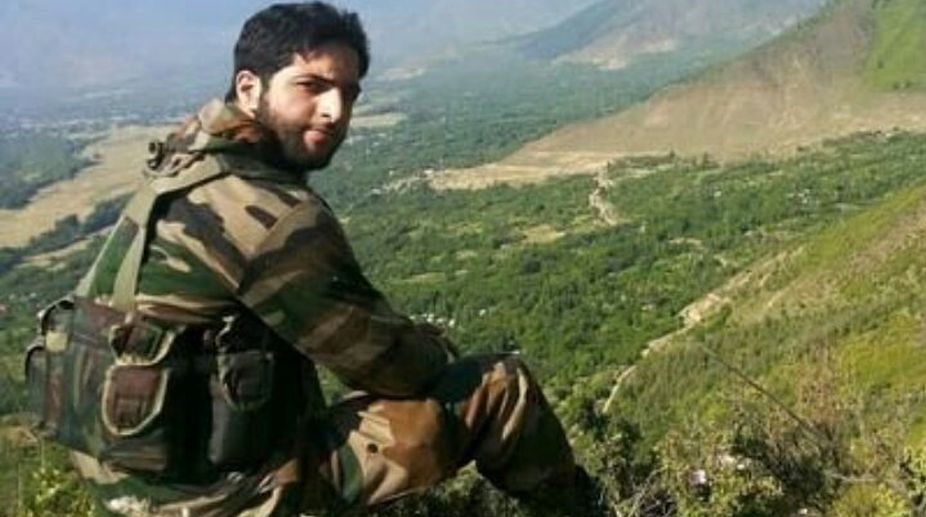
Eight years have passed since the death of Burhan Wani, a Kashmiri militant leader, in a 2016 encounter with Indian security forces. Since then, the situation in the Kashmir Valley has changed significantly, with an increase in violence and a heightened sense of political instability.
July is the month of Wani. He was shot dead in a brief gunfight in South Kashmir on July 8, 2016. Although eight years have passed since his martyrdom, the oppressive Indian forces have failed miserably in suppressing the Kashmiri people’s fervor for freedom, despite their relentless acts of violence, killings, and plunder.
Burhan Wani, born in 1994 in South Kashmir, rose to prominence as a notable figure in the Kashmiri struggle. Despite his family’s relative affluence, Wani engaged in activism from an early age.
By the age of 15, he had become a vocal critic of Indian rule in Kashmir. His charisma and impassioned speeches garnered him a substantial following. Wani effectively utilized social media platforms to advocate against Indian control and to rally support for his cause.
His ability to connect with IIOJK youth, who recognized him as a symbol of resistance against Indian oppression, made him a prominent figure within the freedom movement. He used social media platforms to spread his message and recruit more individuals to join the cause.
Burhan’s death triggered widespread protests and violence in Kashmir. Security forces clashed with demonstrators, resulting in over 120 deaths and thousands of injuries and arrests. The use of pellet guns by Indian forces caused severe eye injuries to many protesters. Burhan’s funeral reportedly drew a massive crowd, with estimates ranging from 100,000 to 200,000 mourners.
The unrest following Burhan Wani’s death wasn’t short-lived. It extended for a significant period and continues to simmer in the Kashmir Valley, albeit with varying intensity. Wani’s death is arguably the most impactful event in the Valley since the armed insurgency began in the late 1980s.
Despite hundreds of deaths in recent years and stricter measures against civilian dissent – which gained prominence after Wani’s death – Kashmir remains a volatile region. Some observers once suggested Wani’s influence would grow after his death. The ongoing situation seems to support this view, with his popularity demonstrably increasing since the encounter.
Burhan Wani’s death, which authorities may have viewed as a resolution, instead marked a turning point for Kashmir. A younger generation, increasingly critical of Indian rule, emerged willing to engage in violence.
Wani, even before his death, had already begun a shift in the approach to militancy. He attracted a growing number of young recruits. Following his demise, this trend continued, with South Kashmir becoming a center for a new wave of militancy.
In 2017, over 207 militants were killed in the government’s “Operation All-Out” (OAO), and over 81 civilians were also shot dead. Many of these civilians were out at the gunfight sites to help the trapped militants escape. As per the official data, there was a jump of 167 percent in civilian killings in 2017 compared to 2015, and a 6.21 percent increase in the number of militant terrorist incidents compared to 2016. The number of militants killed went up by 42 percent.
During the years of 2015, 2016, and 2017, over 300 civilians have been killed by government forces across various operations. The continuous killings have only led to more youths joining the militancy, often by snatching weapons from on-duty government forces.
According to Kashmir media services, more than 96,320 Kashmiris were killed by the Indian forces.
| (From Jan 1989 till 30 Jun 2024) | |
| Total Killings | 96,320 |
| Custodial killings | 7,341 |
| Civilian arrested | 171,627 |
| Structures Arsoned/Destroyed | 110,515 |
| Women Widowed | 22,976 |
| Children Orphaned | 1,07,963 |
| Women gang-raped / Molested | 11,264 |
In 2018, despite ongoing security operations, over 100 young people reportedly joined militant groups in Kashmir. Some observers attribute this rise in militancy to the events following Burhan Wani’s death, which revitalized anti-Indian sentiment in the region over the past two years.
The surge in militancy coincides with a period of political instability in the Valley. Following the 2014 elections, the Bharatiya Janata Party (BJP), a Hindu nationalist party led by Prime Minister Narendra Modi, formed a coalition government with the regional People’s Democratic Party (PDP). This alliance proved controversial, with critics alleging it heightened communal tensions and allowed for a more aggressive security posture.
Public demonstrations in response to militant deaths were substantial, with thousands attending protests and funerals. The environment for political engagement deteriorated significantly, making dialogue seem unlikely.
Burhan Wani was a prominent figure who became a symbol of resistance for some in Kashmir. His death resulted from a security force operation. The Pakistani government criticized the killing and expressed support for the Kashmiri people. Wani’s death also brought renewed focus to the issue of human rights in Kashmir and calls for international involvement.
Burhan Wani’s death proved to be a significant event in Kashmir. It coincided with a renewed focus on the region, particularly among younger Kashmiris, who increasingly used social media to highlight their perspective on the Kashmir issue. The consequences of Wani’s death continue to influence the ongoing debate about self-determination in Kashmir.
Wani remains a prominent figure for some in Kashmir, seen as embodying courage, resilience, and the ongoing pursuit of Kashmiri activism.
